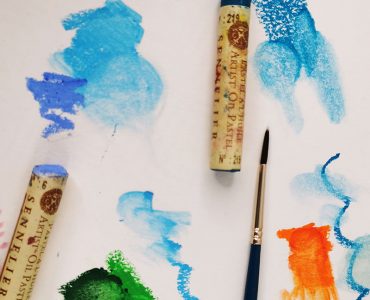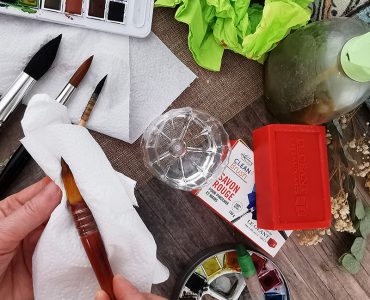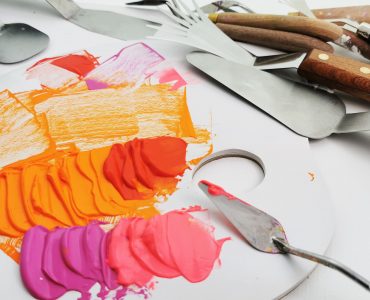Have you ever tried making your own paints? Our GreatArt blogger Jo York gave it try with some very pleasing results!
Sennelier Pure Artists’ Pigments
“For my latest GreatArt Blog post, I’m taking a look at Pure Artist’s Pigments in their powder form…GreatArt stock a range of these on their website and also in their flagship London store…I’m using a gorgeous range by Sennelier.”

It also gives you loads of options in that you can choose to:
- Experiment with the pigment as it is, in a dry powder form
- Colours can be mixed both in their dry powder state, and also when combined with any of the various binders listed below.
- Combine with watercolour medium
- Mix with Acrylic Binder
- Combine with an oil painting medium
- Make Egg Tempera using egg yolk


Before you start making paint..
“The image above shows some of the pigment colours I tried, with tiny amounts ‘spooned’ onto a glass slab ready for use.”
“Here the colours are straight from the jars…the pigment comes very finely ground, but depending on weather conditions there may be some clumping. Although it is perfectly possible to use the pigments as they come, my preference if I’m going to mix pigment with any binder is to give the pigment a final grind with a pestle and mortar, for a beautifully smooth, silky result. If you look very closely in the image below, it’s possible to see a slight graininess in the paint, here made by combining with a watercolour medium.”

“You can see clearly the slight grittiness in the sample above; and it is especially noticeable in the 2nd and 3rd strips. Hopefully this second sample image is clear enough to see the difference a brief grind in the mortar makes, as a result you can see the sample paint strip on the right is totally smooth.”

Preparing your equipment
“So if you want to experiment with using dry pigment for the first time, I recommend trying a small number of colours; perhaps the primaries, some multi-technique paper, and your chosen binder for watercolour, oil or acrylic…

- A flat plastic or glass slab or palette/ paper plates
- Paper towels
- Brushes for painting and a soft brush for applying dry pigment
- A couple of palette knives for smooth blending of pigment with binder
- Removable quality masking tape for masking
- A spray bottle for water
- Mortar and Pestle for grinding (you can often pick these up from charity shops…buy a small one with a good smooth surface)
- Pots for mixing and screw topped jars for storing paints
- Plastic spoons
- Spray bottle
- Washing up Liquid and Sansodor
Combining pure pigment with Oil Binder
“Mixing oil colours using Oil Binder and pigment is really easy because you simply add a small pool of oil binder to a little mound of fine pigment, mixing carefully with a palette knife as above. Oil bound pigments produce a richly coloured but relatively thin textured paint. In order to get the texture you like to work with, it is also possible to add other oil mediums like painting butters. A major advantage is that oil binding medium produces a fast drying oil colour”



Jo’s Top Tips
- *As with any powdered medium, handle with care so as not to inhale dusty pigment. Pigments come in screw topped jars with inner seals-so carefully spoon out small quantities to use ( the pigment is pure and therefore very intense and powerful-you really don’t need much!). Keep jars closed to avoid spillage and contamination of colours.
- Mix sufficient colour for the area you want to paint. If you may need to work over a number of sessions, the paint will keep if stored in a jar with a tightly fitting lid. I keep small jam jars etc…which work really well. I wouldn’t recommend keeping for long periods because this avoids the media deteriorating.
- Cleaning up equipment: Oils-should be cleaned up as with standard pre-mixed oils. Clean off excess paint using rag or paper, then clean with Sansodor or similar, finishing with a wash in warm soapy water.
- Plastic glue spreaders or palette knives are good for scraping the fine pigment out of the mortar.
- I suggest working on Multi-technique/Mixed Media paper for experiments and samples. Acrylics and oils can be worked onto specialist acrylic/oil papers, boards or canvas. For work in oils, acrylic and tempera on canvas, prepare with a gesso base for best results.

All images are © Jo York www.joyorkart.co.uk
Find all Jo’s posts published in GreatArt online Magazine by clicking here!
GreatArt – your art superstore
Art supplies, ideas and advice for all techniques.
GreatArt offers you art supplies for all techniques from:
- traditional fine art painting,
- drawing,
- sculpture
- printmaking,
- graphic art,
- illustration,
- airbrushing,
- model making…
We offer an extensive range of stretched canvas and display products for exhibition, all the art supplies required to create your own bespoke canvases, as well as custom framing and mounting services from GreatArt Store. You’ll also find hundreds of articles and tutorials to browse in the online magazine.





















Add comment